|
Ringneck Doves
Common Names:
Ringneck Doves, Ring-necked Doves, Cape Turtle Dove, & Half
Collard Dove
Scientific Name: Streptopelia capicola
Origin: Southern & East Africa
Relative Size: 11 inches—140-180 grams
Average Lifespan: 10 – 27 years.
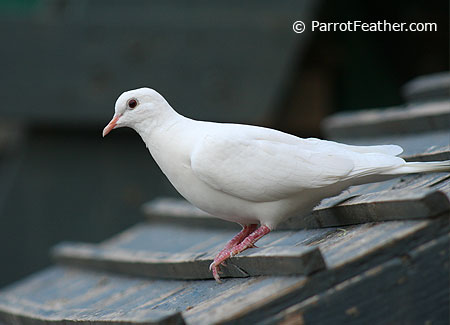
Ringneck Doves make wonderful pets and come in three colors—
brown, beige, and white. These doves are part of the pigeon
family and look similar to the North American Mourning Dove.
These doves are also known as Cape Turtle Doves or Half Collard
Doves in other parts of the world.
In the wild, their appearance is often a darker shade of brown
with a black ring around their collar. In captivity, they come
in many different shades of brown, beige, and white. The white
versions of these doves do not have a black ring; however, they do
exhibit red eyes indicating they are albino. The many mutations
available in captivity are not seen in the wild as they are easily
picked off buy hawks and snakes.
In the wild these doves forage for food on the ground. They
survive on seeds and have been known to eat small insects. Their
habitat consists of low grasslands to open savannahs. Before the
sun sets, they are often seen on the ground collecting seeds
before finding a place to roost. It is not uncommon to see them
in groups of a hundred or more while drinking water.
Ringneck Doves in Captivity
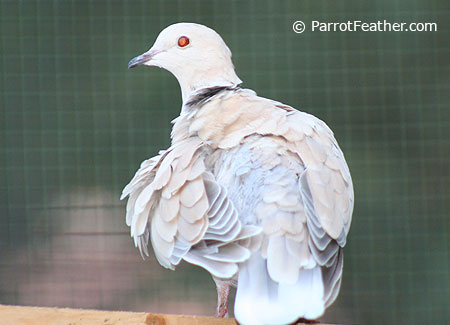
Ringneck Doves in captivity are popular pets. They are often used
as props for magicians as they are small and very friendly. Many
bird breeders enjoy keeping these doves inside their aviaries as
they are community birds and get along with smaller birds.
Because these birds come in pure white they are often showcased in
cages for weddings or major events symbolizing purity, peace, and
love. It’s important to note these doves cannot be released as
they will die in the wild. These birds have been domesticated and
do not know how to survive without human aid nor will they know
how to avoid predators that will easily prey upon them. If one
wishes to release white doves for an event then a white trained
homing pigeon is required.
Ringneck Doves as Pets
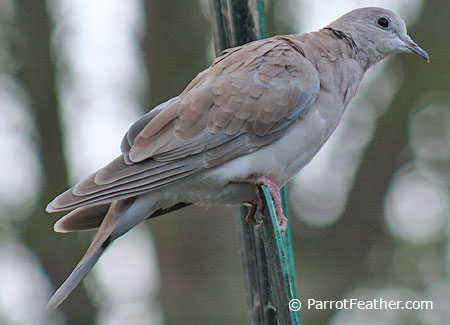
These doves make wonderful pets for many reasons. They are
wonderful for children as they do not bite and have a friendly
demeanor. They will easily sit upon their owner’s shoulders and
just hangout if allowed. Having a handful of parakeet seeds or
extra bread crumbs on hand while holding this dove is ideal as
they will quickly enjoy a quick snack while out. Though they are
not acrobatic like parrots, they make up for it through their
interaction with their owners. They will gladly allow their
owners to pet them and caress their feathers while being out.
Another benefit of owning a Ringneck Dove as a pet is they easily
remain tame once tamed even when placed among other Ringneck
Doves.
The taming process is simple due to the fact these birds have been
in captivity of hundreds of years. They seem to have no fear of
human interaction from the get go. If your pet dove seems to shy
away from handling, gradually try to coax him with seeds to step
on your hand. Do this daily and the bird will eventually come to
associate his owner as a positive experience. Only then should
the owner try to pet the bird.
It does not matter if the bird was purchased as a baby or an
adult—both make wonderful pets. A baby Ringneck Dove does not
have to be purchased young to tame like other bird species.
Breeding Ringneck Doves
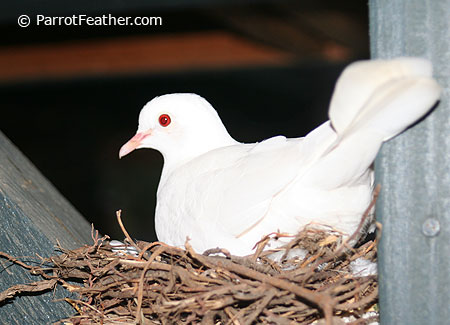
Breeding Ringneck Doves is easy compared to most birds. In fact,
they require very little maintenance to get them started. All
that is needed is a compatible pair, any male and female, and a
nesting site. When getting doves ready to breed most breeders
usually install nesting boxes inside the cage to simulate
breeding.
A dove breeding box should be used; however, any container inside
the cage will do. If a dove breeding box is used, pine shaving
should be placed into the nesting box as this helps the eggs from
rolling and breaking.
When the doves start to show interest in mating, the male dove
will start to display and coo. He will build a nest with a few
twigs. Most nests are simple and not elaborate. Placing a few
pine needles or smaller twigs will do the trick.
Once the nest is completed and mating done the female will only
lay two eggs. During the incubation period, which is 14 days, the
female will only leave the nest to eat and turn the eggs. Around
1-2 days before hatching, the babies will make a small hole which
allows them to breathe air. Soon after, the babies will hatch and
once complete, the mother will discard any eggs shells.
Baby Ringneck Doves
Baby Ringneck Doves grow quickly. As soon as they start to hatch,
they continue to double in size every day for the first week. By
the time the babies are 4 weeks old, most are weaned and have left
the nest. In most cases, the female will try to produce another
two chicks; however, it’s best to remove the nesting box as this
gives her plenty of time to rest until next breeding season. Most
breeders will allow only 2 clutches a year and some only allow
1—the choice is up to the breeder.
Housing Your Ringneck Dove
When keeping Ringneck Doves, inside an aviary, there is really not
much to worry about as they are pretty good about not fighting.
Occasionally, you’ll have a few aggressive doves but quarrels are
quickly solved and the birds go about their business. If you
believe a pair is becoming too aggressive, then re-caging them or
re-homing them might be a better option for the breeder.
If the doves are caged as pets, then they need to have a cage
large enough from them to fly from perch to perch and turn
around. Placing two parallel perches about 5 inches apart is
ideal. Food and water bowls should never be placed under perches
as they can quickly become contaminated with droppings.
The cage should also have a grill to collect all messes made
throughout the day and to limit direct contact with the dove. In
the wild doves rarely have to deal with any mess as they fly
freely—a cage is a different story.
The cage should be washed weekly and disinfected. Using a 10%
bleach ratio to water is ideal. If the owner wishes to use a more
natural disinfectant apple cider vinegar works well. None the
less, the cage needs to be washed thoroughly and dried before the
doves are introduced back into the cage.
Feeding Your Dove
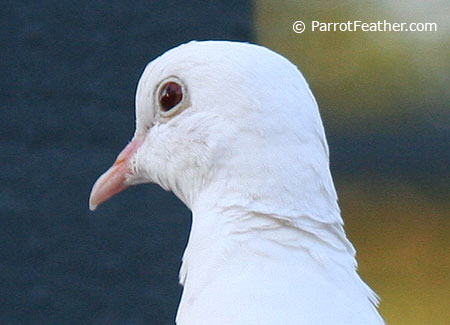
Doves do not have beaks like parrots but that doesn’t mean they
enjoy fresh fruits or vegetables. Cutting or shredding small
chunks of fruit and vegetables is ideal. Greens can easily be
cut and placed into the cage. Use a cheese grader to accomplish
any shredding.
It’s important to note that Ringneck Doves can be finicky when
eating anything new. If you find that your dove will not eat new
foods placed into the cage, continue to add it in anyway.
Eventually curiosity will get the best of the bird and it will try
new foods. You’ll learn what your birds like and what they don’t.
A base food needs to be included as well. They have pellets and
seeds available in the market today. Many breeders buy a nice
blend of dove seed, while others prefer to use cockatiel seed or
parakeet seed. Whatever you choose, it’s important the diet be
supplemented with fresh fruits and vegetables.
|
|
If properly cared for your pet dove can live 15-27 years.
We have
covered the major reasons why lovebirds may bite. Remember
that consistency and patience is the key, never aggression.
It may seem that biting will never stop–in most cases it does,
or significant changes are seen. |
|


